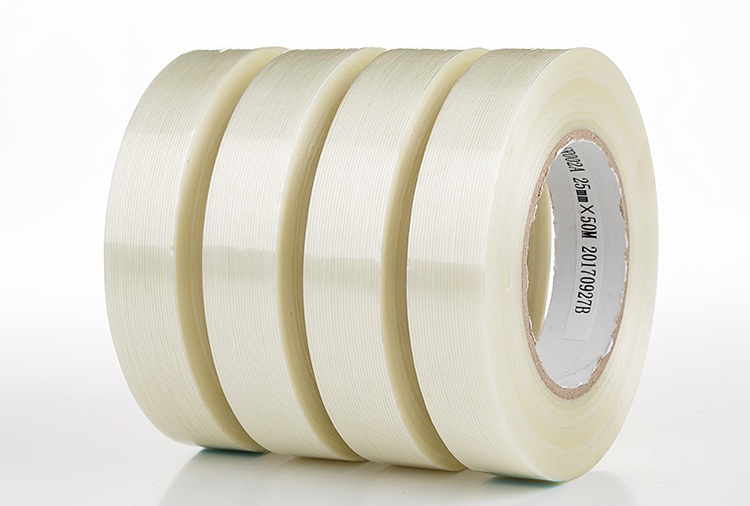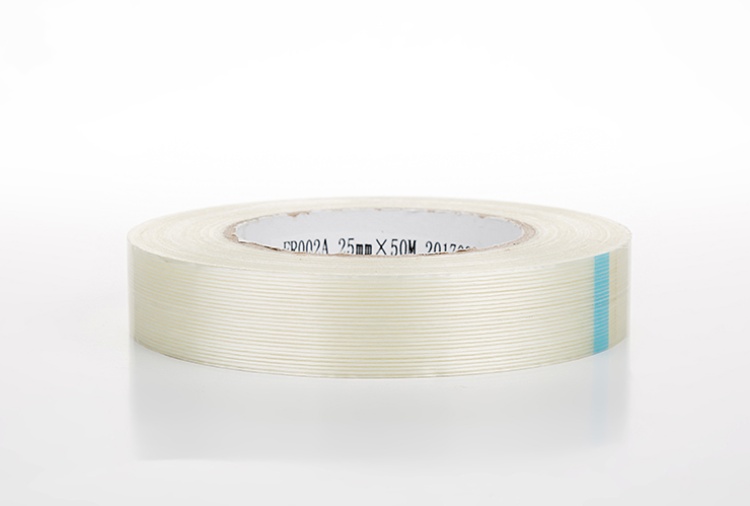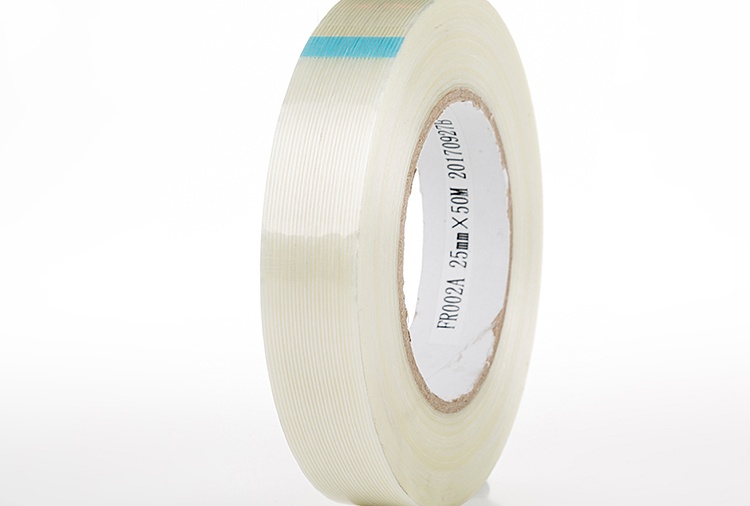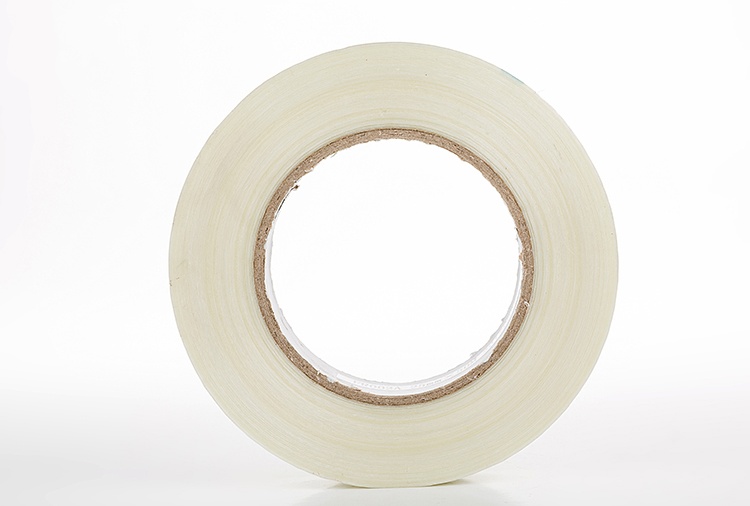



Glass fiber tape
Glass fiber tape has become a core material in the fields of construction, energy, and heavy industry due to its high strength, resistance to extreme environments, and multifunctional adaptability.
Detailed description
It uses PET composite glass fiber thread as the base material, coated with ultra-high viscosity rubber-based pressure-sensitive adhesive, and is used for various heavy packaging as well as high-strength fixing and bonding.
Related Specifications
| Name | ltem No.Model | Material | Colour | Adhesive | Tack | Adhesion (N/25mm) | Tensile strength(N/25mm) | Exten-sibility | Voltage withstand | Temperature tolerance |
| N | N | N | % | ℃ | ||||||
| Glass fiber tape | FRO02 | Composite materials | / | Rubber | 5↑ | 16↑ | 400↑ | 3 | 5KV | 100 |
| Glass fiber tape | FR003 | Composite materials | / | Acrylic | / | 8↑ | 300↑ | 5 | / | 100 |
FAQ
Lens Protection Tape Series
Specialized for encapsulating resin eyeglass lenses during high-temperature curing processes. Key features include high transparency, residue-free removal, and heat resistance up to 130°C (e.g., JT8860 for blue-light-blocking lenses)
Lithium Battery Tape Series
Includes termination tapes (for electrode insulation), PACK tapes (bundle fixation), and tab lead tapes (welding point protection). Made from PI/PET films with electrolytic corrosion resistance, critical for cylindrical/pouch cell safety
LED Encapsulation High-Temperature Tape Series
Designed for LED epoxy resin filling and curing (e.g., MY68C transparent tape for digital tubes). Withstands 150–180°C, prevents overflow, and leaves no residue after peeling
Connector Tapes Series
Insulating tapes for electronic connectors and terminals, ensuring stability in soldering (reflow peak: 260–300°C). Commonly uses PI films for dielectric strength
Insulation & Fixation Tapes Series
Glass fiber-reinforced tapes for coil binding in motors/transformers, offering mechanical strength and flame retardancy (180–220°C continuous use)
High-Temperature Double-Sided Tape Series
Features acrylic/silicone adhesives on PI/PET bases. Used for bonding heat sinks, battery modules, and composite materials, withstanding 120–180°C long-term
Masking Tapes Series
Includes high-temp masking paper and PET green tapes for spray painting, powder coating, and PCB gold finger protection. Resists solvents, leaves sharp edges, and operates at 150–230°C
Teflon Tape Series
PTFE-based tapes with ultra-low friction and 260–300°C continuous resistance. Applied in non-stick industrial conveyors, food packaging seals, and chemical equipment lining
Yes, we can develop tailored solutions based on your sketches or ideas to address your business challenges.
The Company serves all customer segments, offering tailored solutions for large enterprises, small businesses, and individual users.
1. High dielectric strength: This is a fundamental requirement for insulating materials, requiring them to withstand high voltages without breaking down to ensure electrical safety.
2. High mechanical strength: This is the foundation for effective fixing. The tape needs sufficient tensile strength to provide a secure hold when bundling coils and wire harnesses without breaking.
3. Excellent temperature resistance: Electronic components generate heat during operation, so the tape must be able to withstand these operating temperatures for extended periods (e.g., 130°C for Class B and 180°C for Class H) to maintain stable performance and resist degradation.
4. Good adhesion: This ensures the tape adheres securely to various surfaces, such as copper wire, metal, and plastic, without warping or peeling.
5. Flame retardancy: Many high-performance insulating tapes require flame retardancy, a crucial factor in enhancing the safety of electronic products.
The performance of insulating tapes is determined by the combination of their backing and adhesive. Different material combinations result in varying insulation levels, temperature resistance, and mechanical strength, catering to a wide range of applications, from general electronics to high-end motors.
1. Main Backing Materials
The backing is the core of the tape, determining its core insulation and mechanical properties.
PET (Polyester Film):
Introduction: This is the most widely used backing material. The well-known “Mylar Tape” is based on PET.
Features: It offers balanced overall performance, with good insulation, high mechanical strength, and an excellent price-performance ratio. Its temperature resistance is typically Class B (130°C).
PI (Polyimide Film):
Introduction: This is the highest-performing film backing material, also known as “Gold Finger Tape” or “Kapton Tape.”
Features: It offers top-tier electrical insulation and exceptionally high temperature resistance, reaching Class H (180°C) or higher. It also exhibits excellent chemical stability and mechanical strength. Glass Cloth:
Introduction: A cloth-like substrate woven from glass fibers.
Features: Extremely strong mechanically, resistant to abrasion, tearing, and high temperatures. Its insulation grade is typically Class H (180°C).
Acetate Cloth:
Introduction: A cloth-like substrate woven from acetate fibers.
Features: This substrate is extremely soft and conforms well to various irregular surfaces. It also readily absorbs insulating varnishes and resins, demonstrating excellent compatibility.
II. Main Adhesives:
Adhesives securely attach the substrate to the component.
Acrylic Adhesive:
Features: Excellent overall performance, strong bonding strength, and excellent temperature and aging resistance.
Application: This is the most commonly used adhesive for PET tapes and acetate cloth tapes. Silicone Adhesive:
Features: This adhesive offers the best heat resistance, remaining stable even at temperatures up to 260°C and leaving no residue after removal.
Application: It is a standard component for polyimide (PI) and glass cloth tapes, leveraging the high-temperature resistance of the base material.
Rubber Adhesive:
Features: Excellent initial tack and low cost. However, its heat and chemical resistance are relatively weak.
Application: Primarily used for PVC electrical tapes and some acetate cloth tapes that do not require high heat resistance.
Summary
1. Motors & Transformers:
This is the most core and classic application. It is used for interlayer insulation of coils, lead wire fixation, slot insulation, and final external wrapping to ensure safe operation in high-temperature and high-voltage environments. Polyester tape (Mylar tape) and glass cloth tape are very common in this application.
2. Lithium Battery Assembly:
It is used for final fixation of battery cells, insulation and fixation of tabs, and insulation and protection during battery pack assembly. PET tape and polyimide tape are the main choices.
3. Electronic Component Manufacturing:
It is used for internal insulation and fixation of components such as capacitors, relays, and switching power supplies. Acetate cloth tape, due to its softness and ease of impregnation, is often used in applications requiring delicate wrapping. 4. Wire Harness & Cable Wrapping:
Used for bundling wire harnesses in automobiles, home appliances, and industrial equipment, it provides securement, insulation, wear resistance, and flame retardancy.
